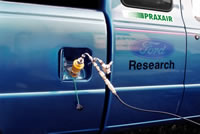
![]()
Hydrogen has a high specific energy, high flame speed, wide range of flammability, and clean burning characteristics which suggest a possibility of high performance in internal combustion engines (ICE). These attributes have been realized for more than half a century since the onset of hydrogen engine development. In the early 1990s, FSEC conducted research on using hydrogen in an ICE. This work resulted in the development of a mixed fuel called HYTEST. Today, automobile manufacturers and DOE continue to work on hydrogen-powered ICEs.
 |
| Hydrogen/natural gas fueling (HYTEST fuel) of Ford Ranger, FSEC H2 Lab (Photo: S. Spencer) |
|---|
As far as the performance of a hydrogen engine is concerned, its limit of flammability in air is the most important factor. Hydrogen's low lean limit of flammability provides an opportunity to use the lean-burn engine (LBE) concept with hydrogen engines quite successfully. The LBE concept refers to engine operation that is leaner (higher air to fuel mass ratio) than stoichiometric (chemically correct air-fuel ratio). The amount of work done during the expansion process in a lean-burn engine is relatively large (due to lower cycle temperature), resulting in a proportionally higher thermal efficiency.
The LBE concept with hydrogen further facilitates and promotes the use of so-called "mixture regulation" or "quality governing" at light engine loads. Unlike gasoline-fueled engines that require throttling at lower engine loads, hydrogen-fueled engines can be operated at reduced power levels by limiting only the rate at which fuel is supplied, without restricting the flow rate of the intake air. Therefore, engine "pumping losses" which occur when the throttle valve is used are completely avoided. Hydrogen's high auto-ignition temperature provides an opportunity to operate hydrogen-fueled engines at higher compression ratios than those normally used with gasoline engines. The result is a further gain in indicated thermal efficiency.
Impediments to hydrogen utilization in an ICE are caused by its low ignition energy and wide limits of flammability. These make hydrogen engines particularly prone to pre-ignition. The situation is further aggravated by hydrogen's high flame speed. Pre-ignition leads to harmful flashbacks into the carburetor and rough operation and is believed to be due to the development of surface "hot spots." Induction ignition can occur due to excessive temperatures of both combustion chamber components and small surface deposits or suspended particles. Hydrogen's exceptionally low ignition energy requires that the average temperature prevailing within the combustion space during induction be sufficiently low so that the formation of hot spots is avoided. This requires appropriate cooling of the cylinder head, piston, valves, combustion chamber wall, and the use of cold spark plugs (non-platinum tipped spark plugs). One way to reduce the effect of combustion chamber hot spots on the pre-ignition of a fresh charge is to use thermal dilution techniques. The unusual heat and mass transfer characteristics of hydrogen make it almost necessary to rethink the combustion chamber and cooling system design so that hydrogen's unique attributes can be capitalized on to full advantage.
Another important issue regarding the engine operation, especially with near stoichiometric hydrogen and air mixtures, is the extent of NOx formation. This problem has been dealt with using any type of thermal dilution of charge by utilizing excess air (lean burn concept), water injection into the cylinder, and exhaust gas recirculation. The collective findings of many researchers appear to indicate that, in order to take full advantage of the lean burn concept and hydrogen's wide flammability limits to reduce NOx emissions to acceptable levels, it would be necessary to confine engine operation to equivalence ratios of approximately 0.65 or lower. It is also possible to achieve low levels of NOx emission with hydrogen engines utilizing internal mixture formation by DCI or port injection. In the internal mixture formation technique, hydrogen is admitted into the combustion chamber directly and under pressure. This approach has required the development of a high-pressure cryogenic injection system as well as salient combustion chamber designs which promote turbulence and rapid mixing of hydrogen and air in the cylinder. It appears that high-power, lean burn hydrogen engines that also produce minimal NOx emission are feasible.
FSEC staff have conducted major work on the use of hydrogen and natural gas as a fuel for ICEs by examining the prospects of mixing hydrogen with natural gas to improve engine performance and lower engine emissions. Researchers began the work by blending low amounts of hydrogen (5 to 10 percent) with natural gas, but results showed that mixtures of more than 20 percent hydrogen would be required to achieve the desired emission reductions.
This work focused on a mixture of hydrogen-enriched natural gas that allowed for an extended “lean burn limit” and thus lower engine emissions without using a catalytic converter. During this work, FSEC completed a series of tests on a 30-percent-plus hydrogen-enriched methane mixture, which was used to run a 350-cubic-inch V8 engine. Results showed that nitrogen oxide emissions could be lowered by approximately 90 percent in comparison with a gasoline-powered car. FSEC named the hydrogen-methane mixture HYTEST (any hydrogen-methane fuel with hydrogen content greater than 20 percent) and received a patent on the fuel.
For additional technical information on hydrogen ICEs, see: http://www.eere.energy.gov/hydrogenandfuelcells/tech_validation/pdfs/fcm03r0.pdf.
